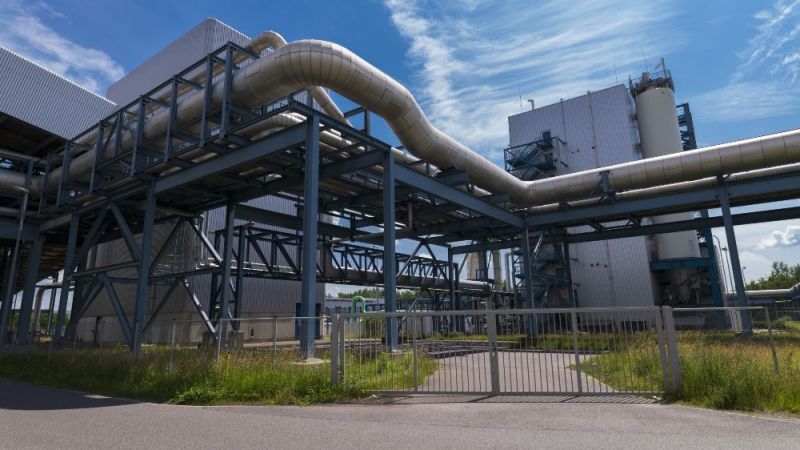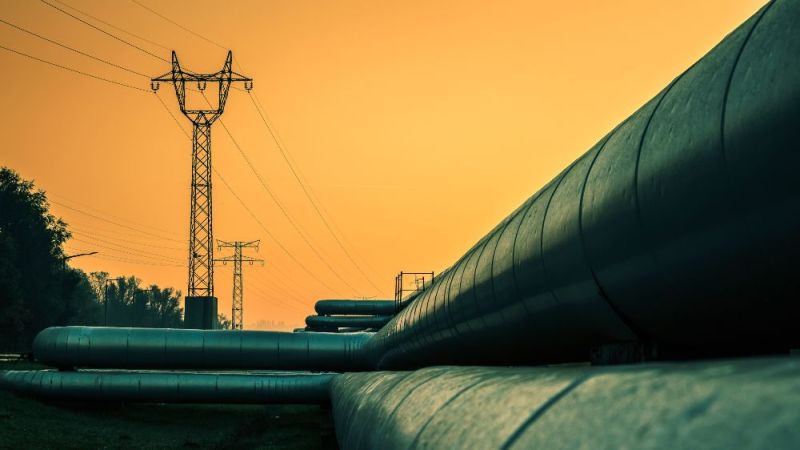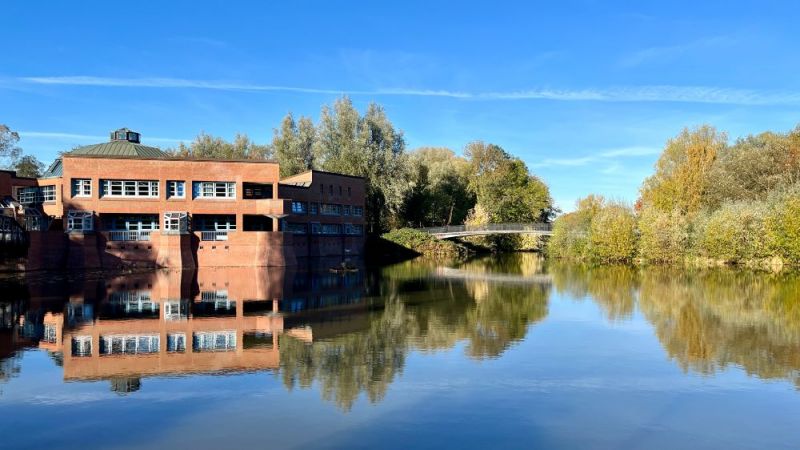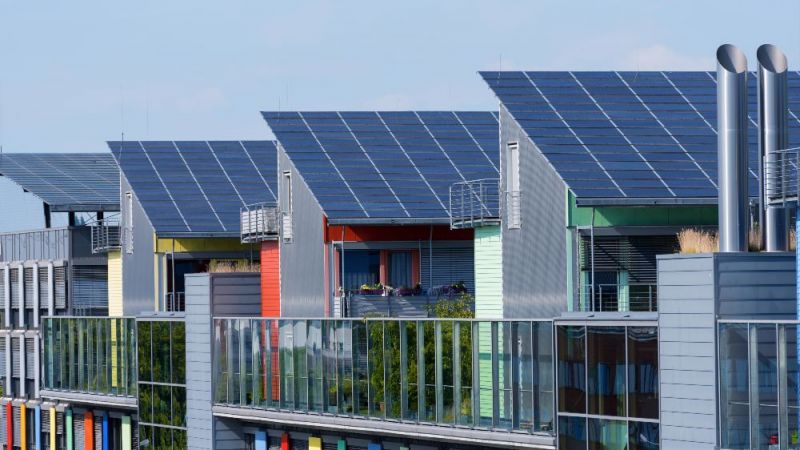
Climate-neutral district
Net-zero energy district
Electrolysis Is More Efficient in Esslingen
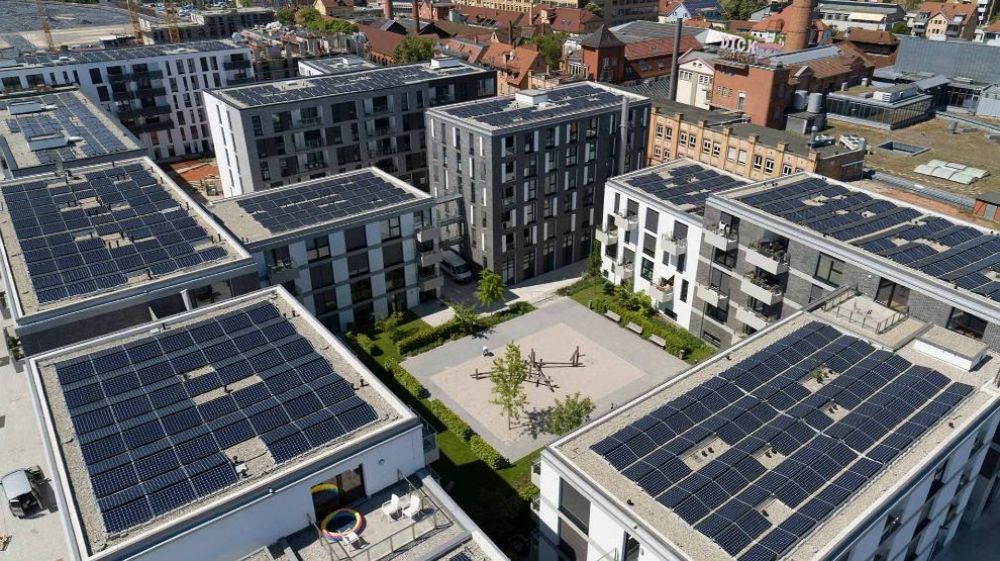
A net-zero urban district is currently being built on the premises of a former freight depot in the west of Esslingen am Neckar. The district is intended to serve as a blueprint for future district development. Citizens as well as representatives from politics and science were able to get a glimpse of what this district will look like in practice during an inauguration event. The first item on the itinerary was a tour through the net-zero district.
For the last three years, over 450 apartments, office spaces, and commercial sites as well as a new building for Esslingen University of Applied Sciences have been under construction across an area of 100,000 m². The first apartments have already been completed, which residents have lived in for the last two years. CO2 emissions per resident for living and mobility are below one tonne per year, meaning that an initial goal of the project has already been achieved.
The research project to establish the “Neue Weststadt” net-zero energy district in Esslingen is particularly defined by its innovative energy concept, in which the electricity, heating, cooling, and mobility sectors are coupled. The focal point of the district’s energy supply is located right in the centre of the district: an electrolysis system utilizes surplus renewable electricity from the photovoltaic installations on the district’s rooftops as well as from the region’s surplus electricity supply to generate green hydrogen.
Efficiency of hydrogen electrolysis to increase from 60 % to over 85 %
A highlight of the event for visitors was an underground tour in which they were able to see the new electrolysis system in the underground energy station. Put into operation in May, it already faces high expectations in terms of hydrogen production: while conventional systems have an efficiency rate of around 60 percent, this figure is expected to increase to over 85 percent for the district’s electrolysis system.

This increase in efficiency is made possible thanks to the location of the system. “With this concept, we have brought electrolysis to the city,” explains Tobias Nusser of the Steinbeis Innovation Center energieplus. “There are already a few facilities operating at around one megawatt in Germany, but they are all out in the countryside, so while they may well be near the energy producers, generally they are far removed from the cities where the energy is in demand.” Its location in the district has one crucial advantage: waste heat from the electrolysis process can be used to supply heat to neighbouring buildings. The transport routes for the utilization of green hydrogen are also shortened.
“To this end, the building technology is being oriented towards this heat source and we are using a low-temperature system, thus replacing fossil fuels such as natural gas,” explains Nusser. The effect should also be magnified by the fact that while the waste heat is used to heat the district itself, other Esslingen residents can also use the green hydrogen, since it is currently also being fed into the gas network and reduces the proportion of natural gas there.
Hydrogen subsidy for promoting hydrogen feed-in into gas network
Operating company Green Hydrogen Esslingen has developed an innovative business model that allows for the commercialization of the fed-in hydrogen. The hydrogen is bought from an energy supplier and the additional costs are incorporated in the price of green gas products. “It is a kind of hydrogen subsidy for promoting more environmentally friendly gas,” says Nusser. Assuming a gas price of 6.15 cents per kilowatt-hour, this subsidy could be set at around 0.05 cents. For a typical family, this would mean less than one euro per month in additional costs.
There are also other possible uses for the 400 kilograms of hydrogen that the electrolyzer is expected to produce every day. Over the course of a day a filling station could fill the tube bundle of a trailer, which then takes the hydrogen to industrial customers. There is also the idea of a filling station for fuel cell vehicles. However, there will not be a large store of hydrogen in Esslingen, thus saving Green Hydrogen Esslingen the expense of construction and the associated approval process. Thirty kilograms will be sufficient, since the hydrogen is expected to be removed immediately.
“But our method of operation will also be based on the availability of renewable energy sources, another important aspect of the project,” explains Nusser. He envisages around 4,000–5,000 hours of operating time per year – with hydrogen thus being produced around 50 percent of the time. The electrolyzer might be able to constantly pull electricity from the grid, but part of the research project is to trial the approach of using renewable electricity from the grid to contribute to the energy transition.
Hybrid electric buses to the Neckar Forum
The fact that public transport has an important role to play in the Esslingen project was made clear to those in attendance at the end of the tour, as they hopped on electric buses to reach the last stop of the day, the Neckar Forum. The hybrid vehicles were purchased as part of the project. Electrically powered journeys have thus increased by fourfold, with public buses in Esslingen set to be 100 percent electric by 2024.
No environmental protection without municipalities
The second part of the inauguration event, which featured a series of presentations and panel discussions, took place in the Neckar Forum. Those in attendance, including State Secretary Andreas Feicht from the Federal Ministry for Economic Affairs and Energy (BMWi) and Ministerialdirigent Oda Keppler from the Federal Ministry of Education and Research (BMBF), were impressed by the two electrolyzer units. The production of green hydrogen taking place here in an urban environment is unique throughout Germany. In his speech, State Secretary Feicht underlined the role that municipalities have to play in achieving climate targets and thanked those involved in the project for their commitment.

“Anyone who has followed the development of the Neue Weststadt district in the last few years will know about the commitment that has been shown in this project, particularly in terms of climate protection at municipal level,” said Lord Mayor of Esslingen Dr. Jürgen Zieger during the event. “We’re delighted and proud to have successfully integrated such an innovative energy concept – also from an urban development perspective – into this important development project for the city of Esslingen.” Project leader Professor Manfred Norbert Fisch from the Steinbeis Innovation Center energieplus added: “The path to net-zero emissions can only be achieved through a solar/hydrogen economy. In the Neue Weststadt net-zero energy district, we are able to demonstrate how this technology can also be successfully integrated into construction projects at municipal level and thus make a contribution to the much-needed energy transition."
In order to produce green hydrogen in Esslingen, electricity provider Polarstern, public utilities company Stadtwerke Esslingen, and Professor Manfred Norbert Fisch founded Green Hydrogen Esslingen GmbH, which is now implementing the power-to-gas solution in the district with funding from the BMWi.
Funding initiative: Solar Construction/Energy-Efficient Towns
The collaborative project EnStadt-Es_West_P2G2P, which aims to establish a net-zero energy district in Esslingen (Neue Weststadt), is one of six lighthouse projects to emerge from the “Solar Construction/Energy-Efficient Towns” funding initiative launched in 2016 by the Federal Ministry for Economic Affairs and Energy (BMWi) and the Federal Ministry of Education and Research (BMBF). The project consortium consists of 10 collaboration partners. The Steinbeis Innovation Center energieplus in Stuttgart is responsible for the overall coordination and scientific leadership of the project. (bs/pj)






